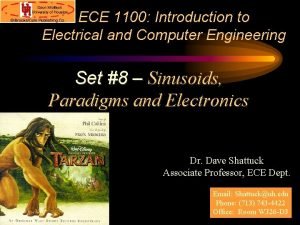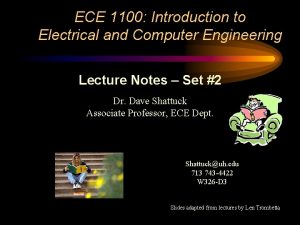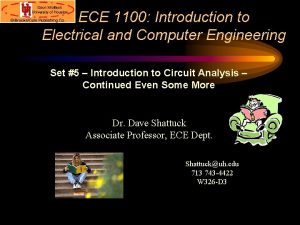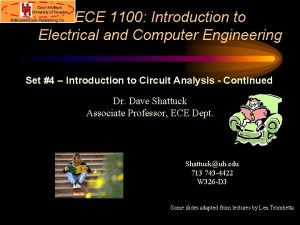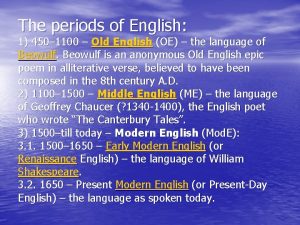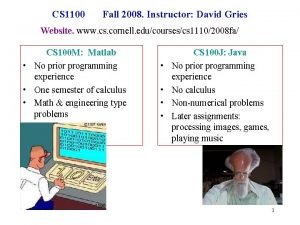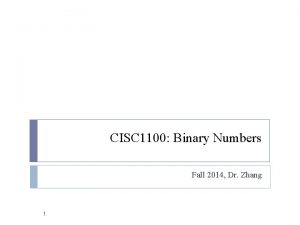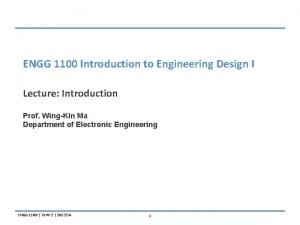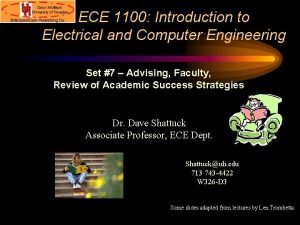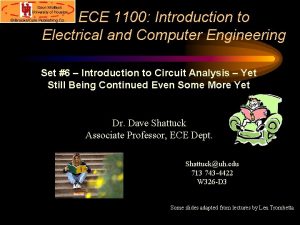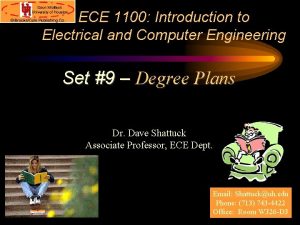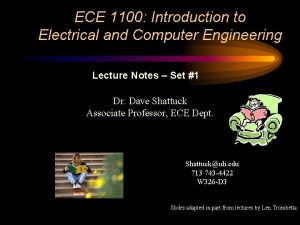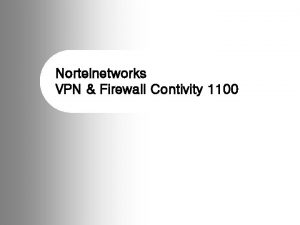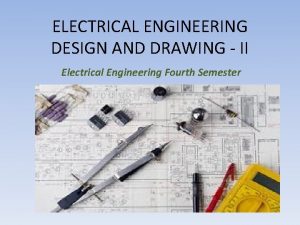ECE 1100 Introduction to Electrical and Computer Engineering


















- Slides: 18

ECE 1100: Introduction to Electrical and Computer Engineering Set #5 – Introduction to Circuit Analysis – Continued Even Some More Dr. Dave Shattuck Associate Professor, ECE Dept. Shattuck@uh. edu 713 743 -4422 W 326 -D 3

Part 3 Circuit Elements

Overview of this Part In this part of the module, we will cover the following topics: • What a circuit element is • Independent voltage sources and current sources • Resistors and Ohm’s Law

Circuit Elements • In circuits, we think about basic circuit elements that are the “building blocks” of our circuits. This is similar to what we do in Chemistry with chemical elements like oxygen or nitrogen. • A circuit element cannot be broken down or subdivided into other circuit elements. • A circuit element can be defined in terms of the behavior of the voltage and current at its terminals.

The 5 Basic Circuit Elements There are 5 basic circuit elements: 1. Voltage sources 2. Current sources 3. Resistors 4. Inductors 5. Capacitors We are going to define the first three here in this module. We will not concern ourselves with inductors or capacitors in ECE 1100.

Voltage Sources • A voltage source is a two-terminal circuit element that maintains a voltage across its terminals. • The value of the voltage is the defining characteristic of a voltage source. • Any value of the current can go through the voltage source, in any direction. The current can also be zero. The voltage source does not “care about” current. It “cares” only about voltage.

Voltage Sources – Ideal and Practical • A voltage source maintains a voltage across its terminals no matter what you connect to those terminals. • We often think of a battery as being a voltage source. For many situations, this is fine. Other times it is not a good model. A real battery will have different voltages across its terminals in some cases, such as when it is supplying a large amount of current. As we have said, a voltage source should not change its voltage as the current changes. • We sometimes use the term ideal voltage source for our circuit elements, and the term practical voltage source for things like batteries. We will find that a more accurate model for a battery is an ideal voltage source in series with a resistor. More on that later.

Voltage Sources – 2 kinds There are 2 kinds of voltage sources: 1. Independent voltage sources 2. Dependent voltage sources, of which there are 2 forms: i. Voltage-dependent voltage sources ii. Current-dependent voltage sources We use dependent sources to model amplifiers. We will not concern ourselves with dependent sources in ECE 1100.

Voltage Sources – Schematic Symbol for Independent Sources The schematic symbol that we use for independent voltage sources is shown here. This is intended to indicate that the schematic symbol can be labeled either with a variable, like v. S, or a value, with some number, and units. An example might be 1. 5[V]. It could also be labeled with both.

Current Sources • A current source is a two-terminal circuit element that maintains a current through its terminals. • The value of the current is the defining characteristic of the current source. • Any voltage can be across the current source, in either polarity. It can also be zero. The current source does not “care about” voltage. It “cares” only about current.

Current Sources - Ideal • A current source maintains a current through its terminals no matter what you connect to those terminals. • While there will be devices that reasonably model current sources, these devices are not as familiar as batteries. • We sometimes use the term ideal current source for our circuit elements, and the term practical current source for actual devices. We will find that a good model for these devices is an ideal current source in parallel with a resistor. More on that later.

Current Sources – 2 kinds There are 2 kinds of current sources: 1. Independent current sources 2. Dependent current sources, of which there are 2 forms: i. Voltage-dependent current sources ii. Current-dependent current sources We use dependent sources to model amplifiers. We will not concern ourselves with dependent sources in ECE 1100.

Current Sources – Schematic Symbol for Independent Sources The schematic symbols that we use for current sources are shown here. This is intended to indicate that the schematic symbol can be labeled either with a variable, like i. S, or a value, with some number, and units. An example might be 0. 2[A]. It could also be labeled with both.

Voltage and Current Polarities • • • Previously, we have emphasized the important of reference polarities of currents and voltages. Notice that the schematic symbols for the voltage sources and current sources indicate these polarities. The voltage sources have a “+” and a “–” to show the voltage reference polarity. The current sources have an arrow to show the current reference polarity.

Resistors • A resistor is a two terminal circuit element that has a constant ratio of the voltage across its terminals to the current through its terminals. • The value of the ratio of voltage to current is the defining characteristic of the resistor. In many cases a light bulb can be modeled with a resistor.

Resistors – Definition and Units • A resistor obeys the expression R i. R v + where R is the resistance. • If something obeys this expression, we can think of it, and model it, as a resistor. • This expression is called Ohm’s Law. The unit ([Ohm] or [W]) is named for Ohm, and is equal to a [Volt/Ampere]. • IMPORTANT: use Ohm’s Law only on resistors. It does not hold for sources. To a first-order approximation, the body can modeled as a resistor. Our goal will be to avoid applying large voltages across our bodies, because it results in large currents through our body. This is not good.

Getting the Sign Right with Ohm’s Law If the reference current is in the direction of the reference voltage drop (Passive Sign Convention), then… If the reference current is in the direction of a voltage rise (Active Sign Convention), then…

Why do we have to worry about the sign in Everything? • This is one of the central themes in circuit analysis. The polarity, and the sign that goes with that polarity, matters. The key is to find a way to get the sign correct every time. • This is why we need to define reference polarities for every voltage and current. • This is why we need to take care about what relationship we have used to assign reference polarities (passive sign convention and active sign convention). An analogy: Suppose I was going to give you $10, 000. This would probably be fine with you. However, it will matter a great deal which direction the money flows. You will care a great deal about the sign of the $10, 000 in this transaction. If I give you -$10, 000, it means that you are giving $10, 000 to me. This would probably not be fine with you! Go back to Overview slide.
